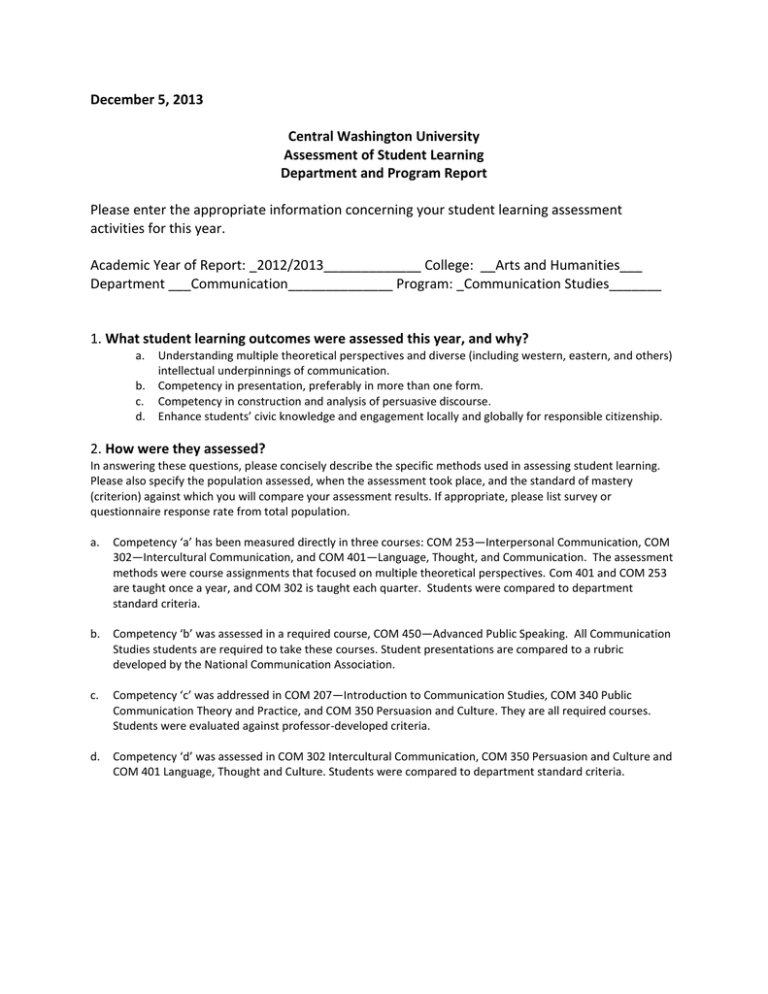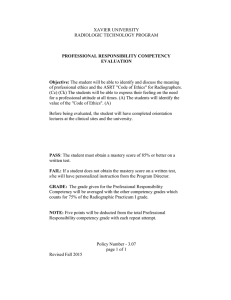December 5, 2013 Central Washington University Assessment of Student Learning
advertisement

December 5, 2013 Central Washington University Assessment of Student Learning Department and Program Report Please enter the appropriate information concerning your student learning assessment activities for this year. Academic Year of Report: _2012/2013_____________ College: __Arts and Humanities___ Department ___Communication______________ Program: _Communication Studies_______ 1. What student learning outcomes were assessed this year, and why? a. b. c. d. Understanding multiple theoretical perspectives and diverse (including western, eastern, and others) intellectual underpinnings of communication. Competency in presentation, preferably in more than one form. Competency in construction and analysis of persuasive discourse. Enhance students’ civic knowledge and engagement locally and globally for responsible citizenship. 2. How were they assessed? In answering these questions, please concisely describe the specific methods used in assessing student learning. Please also specify the population assessed, when the assessment took place, and the standard of mastery (criterion) against which you will compare your assessment results. If appropriate, please list survey or questionnaire response rate from total population. a. Competency ‘a’ has been measured directly in three courses: COM 253—Interpersonal Communication, COM 302—Intercultural Communication, and COM 401—Language, Thought, and Communication. The assessment methods were course assignments that focused on multiple theoretical perspectives. Com 401 and COM 253 are taught once a year, and COM 302 is taught each quarter. Students were compared to department standard criteria. b. Competency ‘b’ was assessed in a required course, COM 450—Advanced Public Speaking. All Communication Studies students are required to take these courses. Student presentations are compared to a rubric developed by the National Communication Association. c. Competency ‘c’ was addressed in COM 207—Introduction to Communication Studies, COM 340 Public Communication Theory and Practice, and COM 350 Persuasion and Culture. They are all required courses. Students were evaluated against professor-developed criteria. d. Competency ‘d’ was assessed in COM 302 Intercultural Communication, COM 350 Persuasion and Culture and COM 401 Language, Thought and Culture. Students were compared to department standard criteria. 3. What was learned? In answering this question, please report results in specific qualitative or quantitative terms, with the results linked to the outcomes you assessed, and compared to the standard of mastery (criterion) you noted above. Please also include a concise interpretation or analysis of the results. In competency 'a', 70 percent of students “exceeded expectations” while none was below expectations. This is a satisfactory result. In competency 'b', 80 percent of our surveyed students exceeded expectations. This is a significant improvement from an already very good result last year. We will keep working to increase the percentage of students that exceed expectations in this competency. Regarding competency ‘c’, 75 percent of our students meet expectations and 25 percent exceed expectations. We would like to see a rise in the number of students who are able to present well using a variety of methods. We will work to develop new methods and assignments to improve in this competence. In competency ‘d’, 100 percent of communication students seem to have implemented assignments with a local or global civic engagement component. Although this is a new learning outcome suggested in last year’s review, it is true that our department, and particularly communication studies, always had a strong component on this subject. 4. What will the department or program do as a result of that information? In answering this question, please note specific changes to your program as they affect student learning, and as they are related to results from the assessment process. If no changes are planned, please describe why no changes are needed. In addition, how will the department report the results and changes to internal and external constituents (e.g., advisory groups, newsletters, forums, etc.). Regarding the subject of presentations, we will improve assignments, strengthen lectures, and make students more aware of the importance of being good presenters in their future careers. As a part of that, we are actively encouraging them to participate in presentations outside of the classroom. 5. What did the department or program do in response to last year’s assessment information? In answering this question, please describe any changes that have been made to improve student learning based on previous assessment results. Please also discuss any changes you have made to your assessment plan or assessment methods. Communication faculty strengthened the research component in this major. As a result, 25 of our students worked on thesis projects last year. 6. Questions or suggestions concerning Assessment of Student Learning at Central Washington University:


